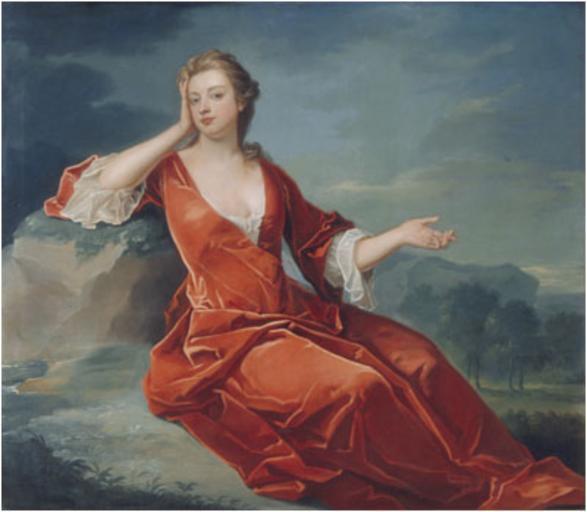MAKE A MEME
View Large Image

| View Original: | Sarah_Jennings,_Duchess_of_Marlborough.jpg (400x349) | |||
| Download: | Original | Medium | Small | Thumb |
| Courtesy of: | www.flickr.com | More Like This | ||
| Keywords: outdoor gown Sarah Churchill (née Jenyns, spelt Jennings in most modern references[2]), Duchess of Marlborough (5 June 1660 (old style) – 18 October 1744) rose to be one of the most influential women in British history as a result of her close friendship with Queen Anne of Great Britain. Sarah's friendship and influence with Princess Anne was widely known, and leading public figures often turned their attentions to her in the hope that she would influence Anne to comply with requests. As a result, by the time Anne became queen, Sarah’s knowledge of government, and intimacy with the Queen, allowed her to become a powerful friend and a dangerous enemy, the last in the long line of Stuart favourites. In an age when marriage was principally for money, not love, Sarah enjoyed an unusually close relationship with her husband, John Churchill, the first Duke of Marlborough, whom she married in 1677. Sarah acted as Anne's agent after her father, James II, was deposed during the Glorious Revolution; and she promoted her interests during the rule of James's successors, William III and Mary II. When Anne came to the throne after William's death in 1702, the Duke of Marlborough, together with Sidney Godolphin, the first Earl of Godolphin, rose to head the government, partly as a result of his wife's friendship with the queen. While the Duke was out of the country commanding troops in the War of the Spanish Succession, Sarah kept him informed of court intrigue, while he sent her requests and political advice which she would then convey to the Queen.[3] Sarah tirelessly campaigned on behalf of the Whigs, while also devoting much of her time to building projects such as Blenheim Palace. She died in 1744 at the age of eighty-four.[4] A strong-willed woman who liked to get her own way, Sarah tried the Queen's patience whenever she disagreed with her on political, court or church appointments. After her final break with Anne in 1711, she was dismissed from the court with her husband, but she returned to favour under the Hanoverians after Anne's death. She had famous subsequent disagreements with many important people, including her daughter the second Duchess of Marlborough; the architect of Blenheim Palace, John Vanbrugh; prime minister Robert Walpole; King George II; and his wife, Queen Caroline. The money she inherited from the Marlborough trust left her one of the richest women in Europe. Sarah Churchill (née Jenyns, spelt Jennings in most modern references[2]), Duchess of Marlborough (5 June 1660 (old style) – 18 October 1744) rose to be one of the most influential women in British history as a result of her close friendship with Queen Anne of Great Britain. Sarah's friendship and influence with Princess Anne was widely known, and leading public figures often turned their attentions to her in the hope that she would influence Anne to comply with requests. As a result, by the time Anne became queen, Sarah’s knowledge of government, and intimacy with the Queen, allowed her to become a powerful friend and a dangerous enemy, the last in the long line of Stuart favourites. In an age when marriage was principally for money, not love, Sarah enjoyed an unusually close relationship with her husband, John Churchill, the first Duke of Marlborough, whom she married in 1677. Sarah acted as Anne's agent after her father, James II, was deposed during the Glorious Revolution; and she promoted her interests during the rule of James's successors, William III and Mary II. When Anne came to the throne after William's death in 1702, the Duke of Marlborough, together with Sidney Godolphin, the first Earl of Godolphin, rose to head the government, partly as a result of his wife's friendship with the queen. While the Duke was out of the country commanding troops in the War of the Spanish Succession, Sarah kept him informed of court intrigue, while he sent her requests and political advice which she would then convey to the Queen.[3] Sarah tirelessly campaigned on behalf of the Whigs, while also devoting much of her time to building projects such as Blenheim Palace. She died in 1744 at the age of eighty-four.[4] A strong-willed woman who liked to get her own way, Sarah tried the Queen's patience whenever she disagreed with her on political, court or church appointments. After her final break with Anne in 1711, she was dismissed from the court with her husband, but she returned to favour under the Hanoverians after Anne's death. She had famous subsequent disagreements with many important people, including her daughter the second Duchess of Marlborough; the architect of Blenheim Palace, John Vanbrugh; prime minister Robert Walpole; King George II; and his wife, Queen Caroline. The money she inherited from the Marlborough trust left her one of the richest women in Europe. | ||||